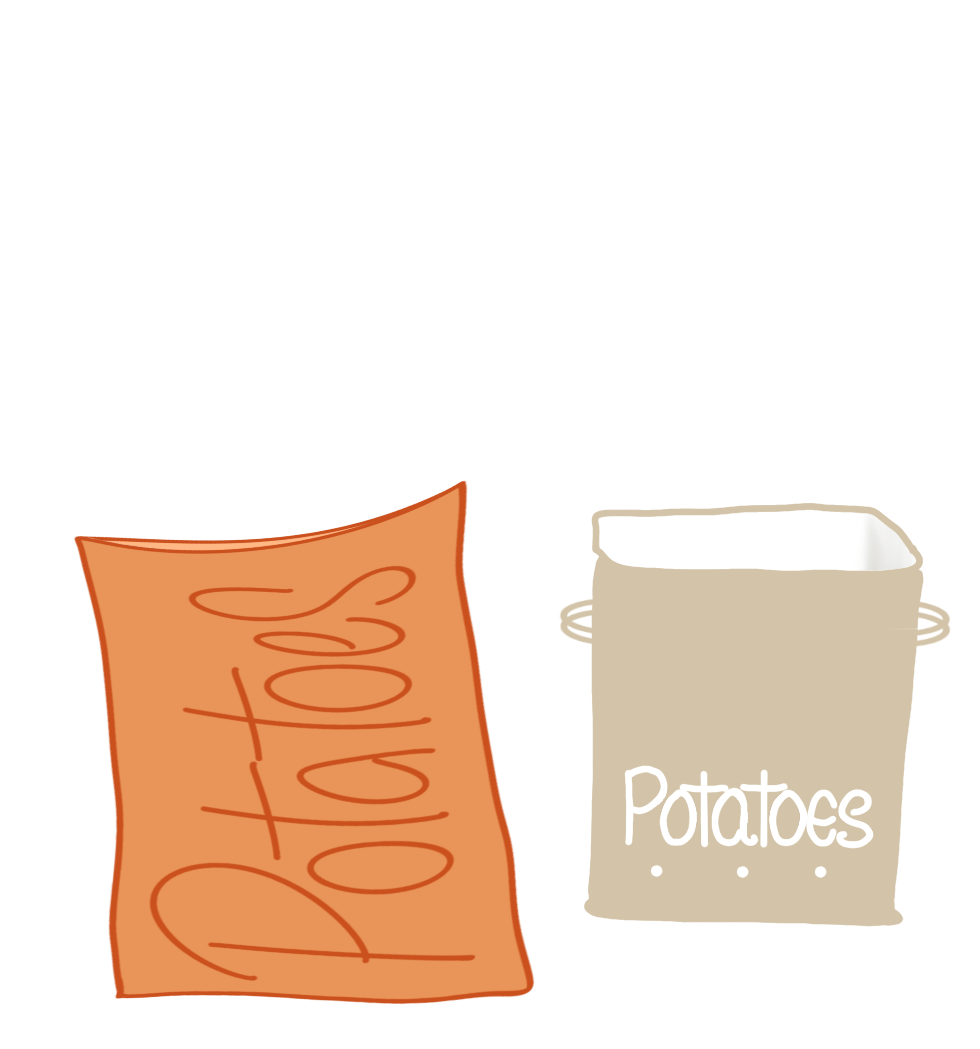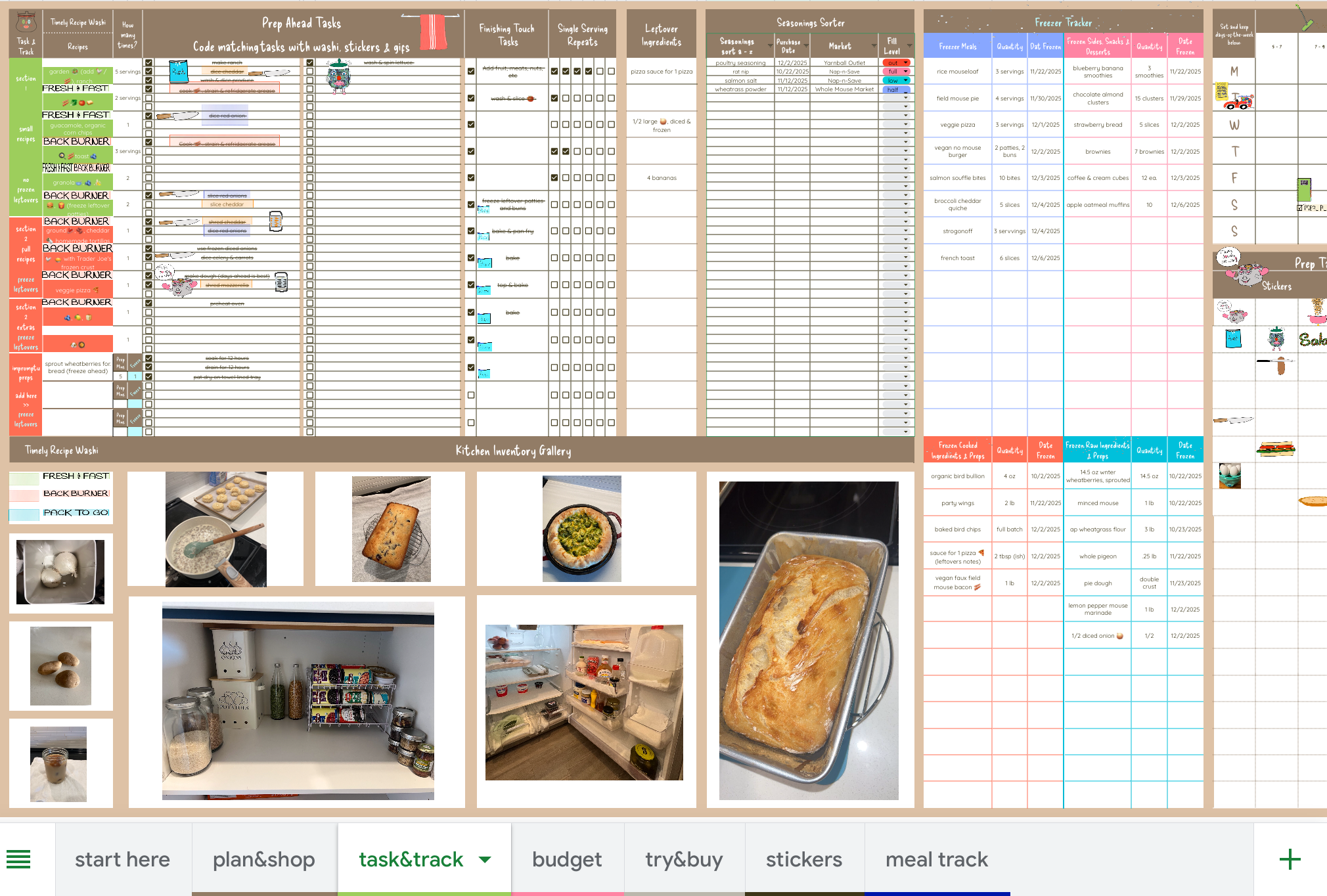(or two).
 Potato bin
Potato binHere's How to Organize Food Inventory in a Cozy Kitchen for one.
Meal planning works best when home ingredient inventory is well managed, but who has time to keep records?
Solo cooks with picturesque pantries, that's who!
Here's how to organize food for image gallery inventory tracking in O.f.O.'s Google Sheets layout:
Image is everything.
Figuring out how to organize food shelves for easy ingredient tracking is a snap for busy singles who take pride in kitchen cuteness. In fact, planning kitchen setup can be fun!
Plan, shop, swap.
- Capture ideas for containers and organizers in O.f.O.'s Try & Buy notepad & image board.
- Pick up good pieces.
- Swap out store packaging for prettier, more practical containers.
Respect your shelf.
Position new pieces to create food storage displays that look so fabulous you'll feel like taking pictures!
Accessorize.
Here are some examples of how to organize food with no-build accessories:
 Glass jars and cruets
Glass jars and cruets- Shelve glass canisters and jars of dry goods like pasta, peas, beans, and flour.
- Pour pantry liquids into pretty glass cruets. Fit mason jars with spouted lids and bottles with pour spouts.
- Extend expandable display risers for seasonings.
- Group loose items into decorative baskets, bowls, and bins.
- Load can organizers with long lasting staples.
- Mount everyday items on the side of the fridge with magnets.
- Keep zip-top bag organizers in a drawer. Gallon sized bag organizers can also dispense pre-cut parchment, wax, and foil sheets one at a time, beautifully!
- Stand, hang or stow zipper-cutting wrap dispensers.
Here are five steps to setting up & maintaining easy image-based inventory tracking:
1. Plan pantry spaces.
Designate specific spaces for dry goods, root veggies, cans, spices, pantry liquids, and all the rest; then shop for storage containers and organizers to create stylish displays.
2. Prioritize fridge perishables.
Can racks and bins free up space, and vacuum sealed glass containers can keep preps fresher longer, but when it comes to conserving food, fridge organization can't replace comprehensive meal planning.
Avoid overfilling the fridge by following weekly meal plans to balance fridge food purchases with freezer and pantry foods.
Keep the fridge setup safely.
- Keep the top shelf partially clear as a cooling station.
- Keep leafy greens in the crisper or salad spinner, separate from other produce and meat.
- Keep raw meat in a bottom drawer, away from other foods.
Keep leftovers notes on the Leftover Ingredients notepad.
- Use the Task & Track page's Leftover Ingredients notepad during cooking, then reference auto-migrated leftovers notes on the Plan & Shop page's Mix & Match Scratch Pad during meal planning.
- Keep leftovers notes in place until ingredients are used up.
- Alternatively, select frozen leftover ingredients may be logged on the Leftover Ingredients notepad in lieu of the Freezer Tracker.
3. Label and log camera shy seasonings & freezer foods.
Labels are important for seasonings and frozen items because they tend to look alike as inventory grows. No biggie. Pretty labels are so lovely on glass containers. As for frozen items, write-on freezer tape is super handy.
Just as labeling is vital for organizing an ever evolving spice rack and freezer inventory, comprehensive tracking and sorting tools are key. That's why O.f.O.'s Task & Track page includes a Seasonings Sorter and Freezer Tracker alongside gallery image fields for pantry, fridge and freezer pics.
The Seasonings Sorter sorts by item, fill level and date of purchase for a comprehensive overview of your entire seasonings inventory anytime.
The Freezer Tracker is clearly categorized for logging items as they are added to or pulled from the freezer.
Free up freezer floor space with bins:
- Bagged freezer meals may lay flat or stand upright within bins.
- Various loose bagged items (like peas) may store neatly in bins.
- Glass bakeware can replace plastic freezer bins.
 O.f.O.'s Task & Track page
O.f.O.'s Task & Track page4. Update fridge, freezer & pantry pics in O.f.O.'s Inventory Image Gallery before shopping.
Take a moment to quickly add pics of food storage racks, shelves, & drawers onto the Task & Track page's gallery just before each weekly shop. But only if you want to.
5. F.I.F.O.
 Dry goods in glass jars
Dry goods in glass jarsTo create a natural F.I.F.O. (first in, first out) flow, position newly purchased items behind duplicate items, so older ingredients are used up first.
Funnels may be used for filling bottles, jars and canisters.
The easiest way to quickly refill partially filled canisters with bulk ingredients is to make a clean swap to a fresh canister. That's why it's important to have an ample supply of canisters and jars. Glass containers are also good for storing various items around the home and beyond!
To top-off canisters/jars with fresh ingredients:
- Fill clean canisters with newly purchased ingredients.
- Top-off with previously purchased ingredients.
- Transfer any surplus into smaller canisters or jars.
- Position smaller containers to be utilized first.
- Place emptied canisters into the dishwasher or hand wash.
Portion & position ingredients for recipe ready use.
Label airtight containers of neatly portioned ingredients like flour and pasta to speed up spur-of-the-moment kitchen time. Weigh or measure typical portions for recipes, like cups, half cups, or Tbsp. of flour or 2, 4, & 8 oz. of pasta.
Create a fun, functional, dump-and-go flow.
Prep ahead by measuring, labeling and grouping ingredients together for tempting, ready-to-make recipe displays.
The glass is always greener.
Why settle for plastic pantry storage, when glass jars, canisters, bottles, and cruets are so much prettier and nicer? Glass may cost a bit more than plastic, but it's still affordable, durable, and worth it! In fact, glass canning jars and cookware are even good for freezer storage!
Freezing glass?
I can't promise that glass won't crack in the freezer, but I have been freezing all types of leftovers in tempered glass for years with good results.
- In my opinion, mason jars are freezable! Metal canning lids, not quite so much. Freezer frostiness can rust metal, but silicone lids are a good alternative.
- The Pump-N-Seal manual vacuum sealing system can make many types of lids vacuum-sealable.
- I freeze bulk flour in a large airtight glass container. I also keep a few cups in glass jars on pantry shelves.
Vacuum Seal Dry Goods in Glass.
Dry goods can be vacuum sealed in glass jars for long term pantry storage. I like the Pump-N-Seal manual vacuum sealing system.
Glass cookware is freezable!
Glass pans with lids are super handy for cooking and baking, fridge storage, and freezer storage. Oven safe glass pans can also make lovely freezer bins.
Counter space is queen!
Counter space is precious workspace and should be kept clean and clear. Crowding counters with dust collecting containers, cookers, and other items can encumber everyday cooking and cleanup tasks.
Store portable cookers and prep machines in cupboards when not in use, unless positioned for daily use, like a cute toaster, coffee maker, or countertop oven.
The short story of easy inventory.
Busy singles can track and protect ingredient investments with ease by creating attractive displays with organizers. Have fun styling the heart of the nest with comfort, color, all the best!